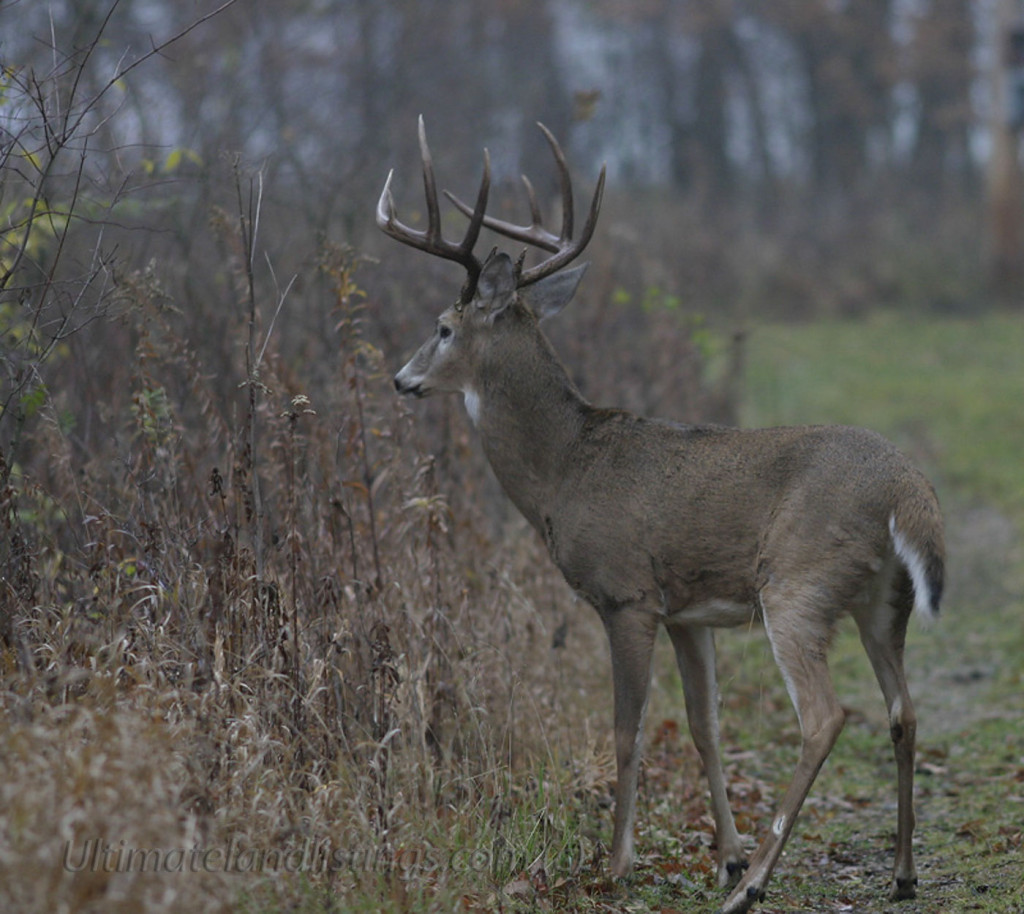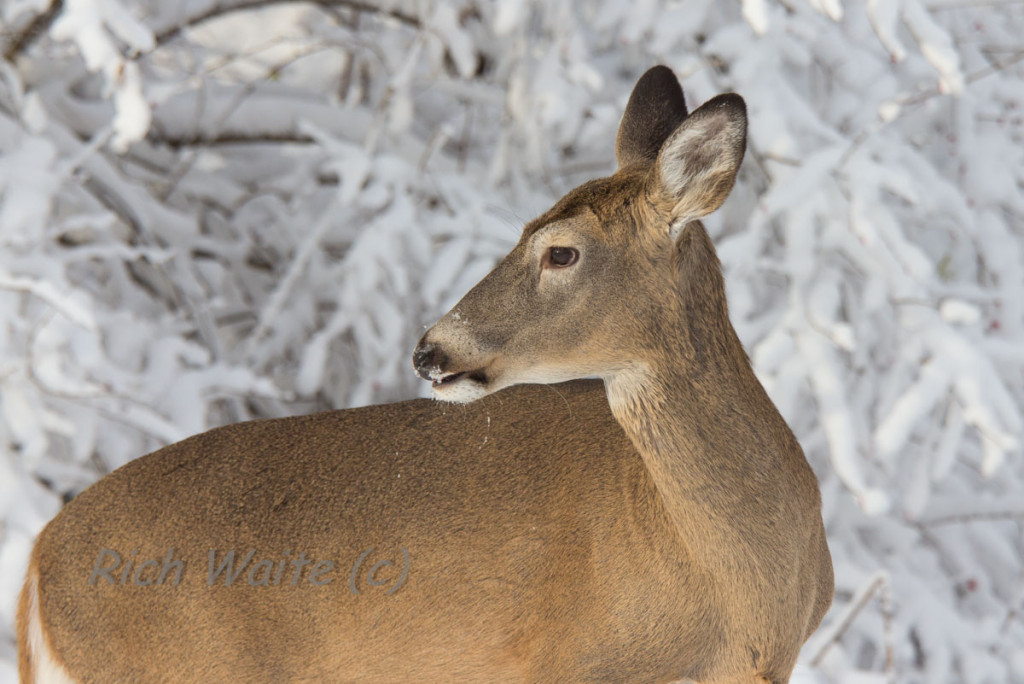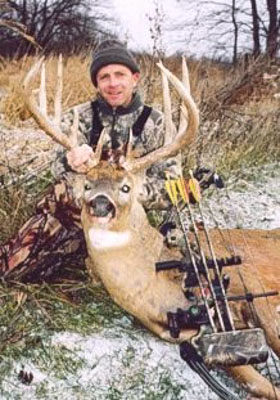With Big Bucks: It’s Better Late Than Ever!
With Big Bucks, Sometimes it’s
“It’s Better Late Than Ever!
By Rich Waite

WHAT IS IT WITH BIG BUCKS?
Seems like they often show up where a person would least expect them. And so it was with those two, standing ever so nonchalantly next to a back-country highway in the middle of a small hay field just after high noon.
Seems weird, I reasoned while pulling my truck to a gentle stop along the edge of the gravel road. I peered through my binoculars to confirm the obvious: Standing shoulder to shoulder some 200 yards away were two bucks – two very LARGE bucks! The smaller looked to be 150 Pope and Young class. The other? He made that one look puny. I watched in shock as they trotted off, noses to the ground. The date was November 30.
That was several years ago, but it was definitely not the last time I would see monster whitetails on the prowl late in the bow season. In fact, I often have seen the biggest bucks of the year late in the rutting period – the last 10 days of November and the first few days of December – throughout the northern two-thirds of the U.S. I’ve taken severalP&Y bucks during the last week of November, and one of those was the biggest buck I’ve ever taken with my bow. Indeed, the back half of November can be the best time to take a big buck with a bow.
Bergman’s Rule comes into play on this, a biological axiom that says the farther north deer live, the larger their bodies will grow. Consider that the average daytime high temperatures are much cooler during late November than they are during early November. Common sense says cooler weather encourages more daytime movement of large-bodied bucks. When the temperature is warm, which it often is in early November, bucks are most active at night when the air is coolest. Remember, throughout the fall whitetails are dressed in full winter attire with thick fur coats. A 300-pound buck most likely will avoid the heat stress of chasing does on hot, early-November days. But when cold weather strikes in late November? He will be far more comfortable moving during the day.
Also, keep in mind that mature bucks are usually the main breeders in the herd. These guys get any and every doe they want. When another buck is around, a simple stare usually intimidates the subordinate animal and the big boy gets the doe.
Of course, during the peak of the rut, when many does are in heat, younger bucks will get at least some of the action. In any herd, the small bucks make up the majority so there is just no possible way for the biggest bucks to do all the breeding. Plenty of other does will be in heat when Mr. Tall Tines is off with a doe, which opens the door of opportunity for the young bucks.
No – the big bucks just can’t keep up with everything happening during the rut! (which also means, that these younger bucks — regardless of how “good” they may become — spread there genetic code! So, culling “inferior” 8 pointers and “freak-rack” bucks out of the herd latter on is a losing cause,for sure. After all, one just can’t predict what is the genetic code that is being spread around by so many young bucks during the rut — but that’s a whole ‘nother article! And, this, perhaps, is not a scientifically perfect analysis, but from my point of view it’s a good explanation of why I see some of my best bucks after the so-called peak of the rut.
My point here is really, that after the peak of the rut, when only scattered does are in estrus, the big bucks pretty much have total control, so they’re the ones that will be most active and visible at that time. The little bucks have no say in the game then! This is also the case during the so called “second rut” , which typically takes place around 28 days after the date of the local peak rut date. Very few does are in estrus then, if any. If a does does come into heat during the window period of the second rut, bucks go frantic! Including giants who often try to run off the other bucks trying to sneak in on the action. Thus, the second rut – though sometimes non-existent – is a great time to be afield with either bow or gun! In Iowa, where I do most of my hunting.

The second rut period coincides with the last half of Iowa’s second shotgun season and the beginning to middle portions of the late muzzle loader and bow season. The weather can be so frightful but the deer hunting can be so delightful!
Let me take you for a ride in my way-back machine. We are going for a stroll back to the 2001 season: I’d been having a ball all season, bouncing around from stand to stand, as wind and weather conditions dictated, trying to out-dupe something big. Trouble was, all the something bigs were out-duping me! Still, I had passed up over 30 bucks, six to eight of which would have exceeded the minimum P&Y measurement of 125 inches. I’d been having a fun season, but my buck tag was burning a hole in my backpack.
Then, on November 24, things seemed ideal as I settled into a stand in a narrow strip of timber, along a good travel route, about 1 pm. Having been on stand only a short time, I was surprised to see movement along a fence row some 250 yards out and to discover amber-colored tines – very tall tines! – rising above the goldenrod stems.
At that same moment Crash! Crash! Crash! echoed through the woods from just 80 yards behind my stand. What in the world? I thought, turning just in time to see a mad-dashing doe with 13 hard-charging bucks tight on her hooves! Most were 2Yz year olds, but a couple appeared to be near Pope and Young size.
Trying desperately to put the brakes on the storm of whitetails I opted to hit the rattle bag hard and followed with a blaaaa blaaaaaaa blaaaaaaaaaa from my grunt tube. Nothing doing. Those bucks wanted that doe, not a phony substitute, and I could only sit back and watch – rather anxiously, I might add.
Right before dusk, the tall-tined goldenrod buck reappeared, now trailing a doe into my timber strip. Patience … patience … patience … , I muttered to myself although, with darkness nearly upon me, patience was hard to come by. Fortunately, encouraged by some soft doe bleats from my grunt tube, the doe edged my way just before the hand of legal shooting light clenched tight, and at 20 yards, my 2314 shaft found the side of Mr. Tall Tines.
ON THAT HUNT, as on all whitetail hunts, the key was being in the right place at the right time. On many of my late-season hunts, the right place may be a brushy fence row, a narrow strip of timber connecting larger woodlots, or any other bottleneck that funnels traveling bucks along a specific route.
Late-rut — including the “second rut” time period — monster bucks often follow relatively predictable travel routes to and from doe hangouts. The key, then, is to identify major doe bedding and feeding areas and to hunt funnels that link those locales.
Of course, the same principles that govern other hunting apply to the late season: you mus always have the wind in your favor, and you must be careful not to over-hunt any one stand (the Ozonics System can help you in this regard! It works!).
I always prefer to have multiple stand sites, and sometimes this means having stands in close proximity to each other to pull off a late season big buck surprise. This lets you, the hunter, play the proverbial “musical chairs” game with your stands, so big bucks are less suspecting of your intrusion.
Remember a big buck will beat you one-on-one in his domain if he knows, or even susptects, you are there – nearly 100% of the time!
Let’s go for another way-back machine ride.
It’s 2002 and I found myself standing 15 feet up a little black walnut tree in a brushy woodlot timber strip travel corridor. The date was November 24, the same date of which I’d killed the Mr. Tall Tines buck the year before. I stood there with big wet, icy, snowflakes pelting my face as I gritted my teeth and tried to keep still on my icy perch, like some sort of rather ugly, giant, bald eagle waiting for a fish below. Snow had been piling up while I waited – maybe 3 inches, maybe 4. My mind started drifting.
I was thinking of a good friend, Kevin Oetken, who stood high in an ancient oak with me the previous day, trying to videotape me shooting some unsuspecting monster buck. We had a close and oh-so-exciting encounter, too, when a 170 inch typical 6 x6 responded to my grunt tube. The beast of most anyone’s lifetime came 30 yards close yet ended up oh so far away from getting a free ride to my house in the back of my Dodge Dakota pickup. We just couldn’t seal the deal as the big buck sensed danger with his 6th sense powers and slipped like a bass covered in Vaseline right past my shooting lane. How did that happen anyway? I don’t know – but my wife reminded me that that’s how they get to be big. Indeed, she is right. (Once again)!
Then, that same afternoon, some 10 miles distant, Kevin and I witnessed a monster-bodied bruiser and several medium racked animals chasing does all around a huge cornfield. And that evening, we’d had several deer cross a fence right under our boots – literally – including a 125 inch Pope and Young class 3 year old that I elected not to draw back on.
Now…back to the present icy perch…. I found myself shivering and trying to maintain my balance on a really much colder than normal even for a late-November Iowa stand. A stand that was piling up with snow. In one of his hit songs, Ted Nugent sang, “Here I stand in a puddle of confusion;’ and now those lyrics seemed to be dancing around in my head. Why didn’t I shoot that 8-pointer the day before? I kept thinking. The gun season will be opening next week. Am I nuts?
Truth is I was having too much fun hunting for big bucks. I didn’t want to stop! And I was seeing more monsters now than earlier in the season.
What’s that? I thought as a strange feeling wrenched my gut, urging me to peek behind my stand. There, some quarter mile away, stood three bucks. Two appeared to be well over the P&Y minimum, but it was the third that made my heart race. He was a monster with a massive, ivory-white rack bursting with long tines! And the bucks were coming my way.
Several does leaped out of a narrow timber strip as the bucks moved my direction. Apparently, none of the does was in estrus and none wanted anything to do with those bucks right then.
I reached for my grunt tube, and then my legs began to quiver as the bitter wet air coupled with intense emotions began to take control of me.
Am I about to get a shot at a potential Boone and Crockett buck? I wondered. And can I hold it together if he does come within range?
To complicate matters , five does I had not seen walked right down the little ravine in front of me and behind my tree, straight downwind of my stand, and started feeding less than 25 yards away. Uh oh! They are going to blow out of here and spook those bucks! Please, God, help me out here, I prayed while holding my breath. Several long minutes passed …
Frozen like a statue, I caught movement out of the corner of my eye. Another doe was heading straight for my stand – with Mr. Mighty Rack right on her heels. 
Blaaaaaaaaa ... the buck grunted in a moaning tone as he finally started to move down the brushy ravine toward my shooting lane. Before I knew it, I was watching my arrow meet p with the side of the monster whitetail, and then the buck and then the buck streaked away like a 250-pound bolt of lightning. Seconds later he lay silent on the forest floor, just 50 yards away.
Let me be clear: I don’t purposely wait until the late rut to hunt for big Iowa bucks — or big bucks anywhere!
However, it seems that sometimes things have worked out that way. Of course, I’m not complaining one bit. Not only did I take good bucks way back in late ’01 and ’02, but I repeated the feat November 23, 2003. But many bucks more recently than these have been spread out over the last 10 years or so. These successes have shown me that late-rut hunting can be very good.
As the old saying goes: It’s better late than never. But if you don’t mind I may twist that around to say that sometimes, “it’s better late than ever!”
Good Hunting!

